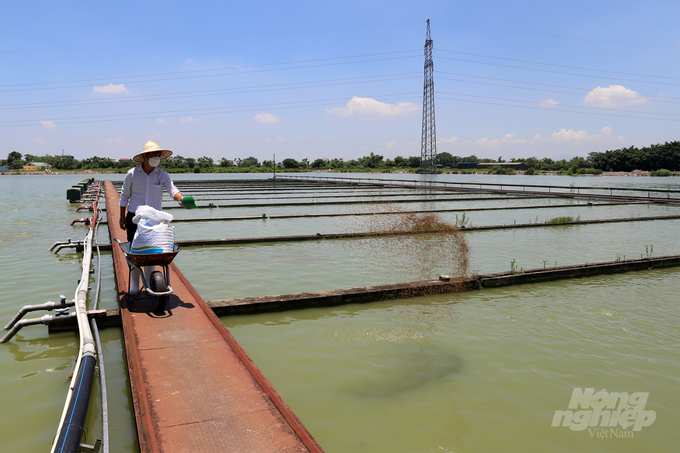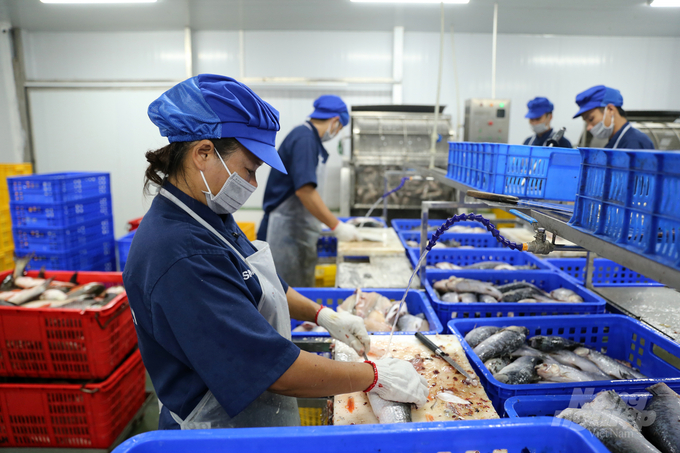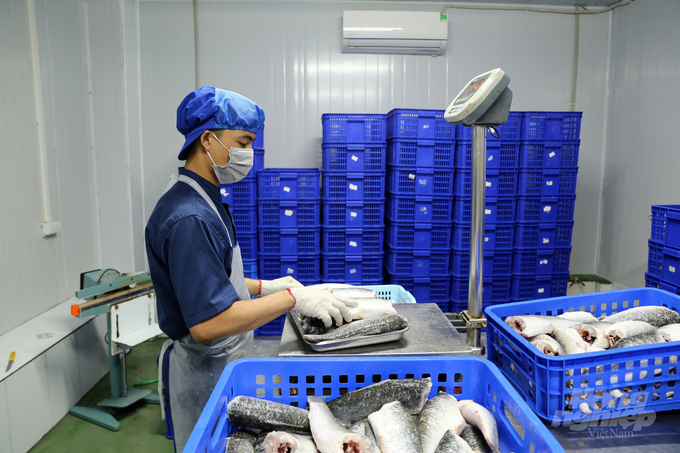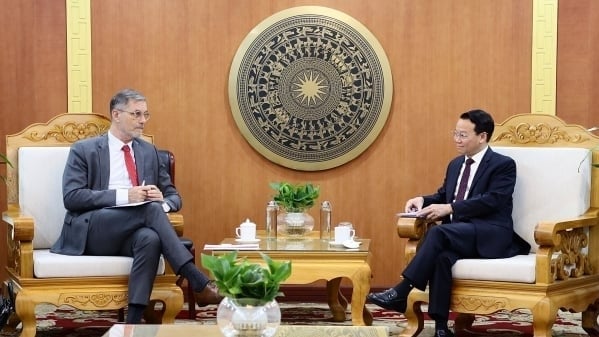May 22, 2025 | 18:34 GMT +7
May 22, 2025 | 18:34 GMT +7
Hotline: 0913.378.918
May 22, 2025 | 18:34 GMT +7
Hotline: 0913.378.918
Nguyen Van Thiem, Deputy Director of Dai Ang Hi-tech Fisheries Cooperative in Hanoi’s Thanh Tri District said that the cooperative established in 2018, now raised river fish in ponds on an area of 10 ha. The pond is equipped with wave generators, flow aerators, water fans, and waste suction machines.
“Our cooperative is a pioneer in raising river fish in the pond in Hanoi,” Thiem said, adding that “the fish had a habit of swimming against the current. With that model, the fish are often active, making the meat firmer and more delicious.”
Currently, the cooperative is raising many types of fish in which tilapia is being consumed quite well in the market, he said.

Dai Ang Hi-tech Fisheries Cooperative is investing in 14 farming tanks with sizes 25 x 5 x 2.5 (metres). It can harvest 12-15 tonnes of fish in each tank, twice a year. Photo: Dieu Vy.
"We raise fish according to new technology, which helps in centralised management, disease control, food, and amount of fish. Fewer workers are required for harvesting,” he said.
However, compared with traditional fish farming, the model requires more cost for feed and electricity plus under the model, fish grew slower.
To ensure a stable supply, the cooperative is building a stable growing linkage chain, completing a closed production line.
Cao Dinh Thanh Hai, director of the cooperative, said that many people were very afraid because they encountered seafood units that promised co-operation and then ran away. To reassure fish farmers, the cooperative provided breeding at the most reasonable price, and at the same committed to purchasing all products for members of the cooperative.
In addition to the on-site source of fingerlings, the cooperative also cooperates with a prestigious breeding center in Bac Ninh. All input resources to support people are charged at the optimal price. At the time of selling fish, a technician will check the quality of the finished fish. When the fish is of good quality and there are no residues of banned substances, the cooperative will come to buy.
"The above linkage model has been deployed a lot in the south, but it is still quite rare in the north. Aquaculture activities in the north are generally still developed in a fragmented manner, with a small area and low output. Northern farmers rarely do intensive farming, mainly polyculture. We have just started to build production linkages to convince farmers," said Hai.
Hai added that his cooperative was aiming for a higher goal of exporting products. However, meeting the export demand was difficult, especially for big markets like the US with the demand for up to 10 tonnes of fish per day. European countries such as Belgium, and the Netherlands are in high demand for tilapia.
"The aquaculture area in the northern provinces is very large, but not concentrated and the farming conditions failed to meet requirements for export. To purchase continuously to ensure the supply, we need to have 100 - 200ha raised in the export farming chain. Only when building a code of a farming area in combination with a large-area fish farming chain, with consensus from the government to farmers, can good results be achieved." Hai said.
The cooperative's fish farm uses aquatic feeds originating from large corporations and companies in the market, so the product quality is highly appreciated by customers. With an area of 10ha, the cooperative's average output per year is over 400 tonnes. Its revenue is more than VND8 billion per year.
“From farm to fork” also known as 3F (Feed - Farm - Food) is a closed safe food production model from raising to processing and consuming products.
Previously, the livestock industry was divided into several stages such as breeding, feed production, farming, processing, and consumption. Each stage had its profits and risks. When a product was refused in the market, it’s hard to identify the responsibility of each stage.
With the 3F model, that all changed. This model requires synchronization from breeding to food production, rearing, processing, and food supply. All must be connected and transparent.

About ten tonnes of raw materials can be handled daily at the co-operative’s preliminary processing - processing area. Photo: Dieu Vy.
Determining the focus on providing safe and quality food, cooperative leaders have implemented a series of solutions from raising to preliminary processing - processing to help farmers no longer have to worry about fish prices and product consumption.
“In 2022, we put the preliminary processing, processing, and preservation area into operation, helping to diversify products to the market. The cooperative's products have been supported by many food suppliers. Up to now, the cooperative has invested about VND20 billion to complete the closed aquaculture and seafood processing chain, "said Hai.
According to Hai, the model from pond to table of Dai Ang Hi-tech Fisheries Cooperative is the first model in Hanoi. Preliminary processing - processing area includes 2 lines and 25 workers that will process 10 tons of raw materials/per day. In the modern closed production line, workers are ready to work overtime when there are large orders.
The leadership of the cooperative traveled to the southern provinces, learning about production models, machinery, and management to build and complete a preliminary processing - processing factory. They also selected highly skilled workers.

Preliminary processing - processing line is in the 3F closed chain "from farm to table". Photo: Dieu Vy.
One of the problems that the cooperative leaders are still concerned about is the ability of farmers to supply raw fish. The market capacity of tilapia consumption is very large. The desire of the cooperative is that people pay attention to raising fish with the right techniques and quality to make a profit and a stable income.
Cooperatives are willing to sign contracts with households raising fish in chains, as long as the farming households must ensure the quality of the water for raising, the breed, and do not use antibiotics and banned substances.
“If we can a production chain, we are ready to invest in an IQF (high-speed freezing system for bulk products) production line to ensure a good supply of seafood products to the market. ", emphasized Hai.
"Recently, in April 2022, the cooperative exported 18.5 tonnes of fish to the US, and the feedback from customers is very good. In the coming time, the cooperative will continue to build a linkage model with farmers to expand supply.
In addition to continuously expanding the farming chain to focus on the existing customer base, we also strive to meet the different needs of customers. Specifically, American consumers only eat 5-to-7 ounce tilapia, while Vietnamese farmers are still used to traditional farming, often selling fish weighing more than 1kg/head," said Hai.
Translated by Hien Anh
![Reducing emissions from rice fields: [3] New values generated from carbon credit](https://t.ex-cdn.com/nongnghiepmoitruong.vn/608w/files/content/2025/05/19/dsc09613-144700_71-150957.jpg)
(VAN) In addition to helping safeguard the environment, the low-emission rice cultivation model also generates new opportunities for farmers by leveraging the carbon credit market.
![Ho Chi Minh city adapts to climate change: [1] Vulnerable in the whirlwind of development](https://t.ex-cdn.com/nongnghiepmoitruong.vn/608w/files/duyenht92/2025/05/19/3131-ngap-nongnghiep-163121.jpg)
(VAN) As the country's economic engine with a rapid urbanization rate, Ho Chi Minh city is facing increasingly serious consequences of climate change.

(VAN) On May 21, Minister of Agriculture and Environment Do Duc Duy worked with Mr. Olivier Brochet, Ambassador Extraordinary and Plenipotentiary of the French Republic to Vietnam.

(VAN) VRG recently conducted a visit and working trip to the United States to demonstrate its efforts in redefining the role of rubber enterprises in the global value chain.

(VAN) In 2024, over 295 million people across 53 countries and territories faced acute hunger—an increase of almost 14 million people compared to 2023, while the number of people facing catastrophic levels of hunger reached a record high.

(VAN) World Environment Day 2025 (June 5) carries the theme 'Beat Plastic Pollution' continuing to emphasize the global urgency of addressing the plastic waste crisis.

(VAN) This was the assessment shared by experts at the workshop titled 'Assessing the Role and Potential of Low-Emission Rice Production Systems in Vietnam,' held on the morning of May 19.